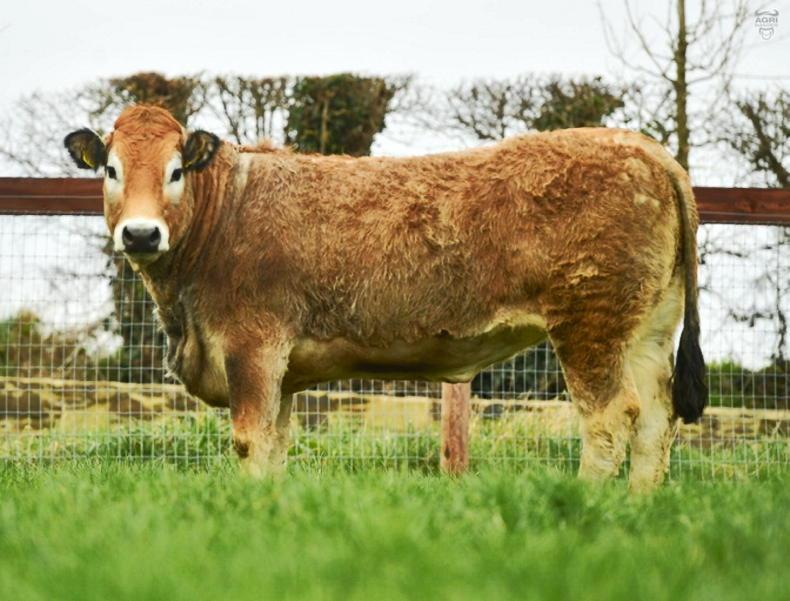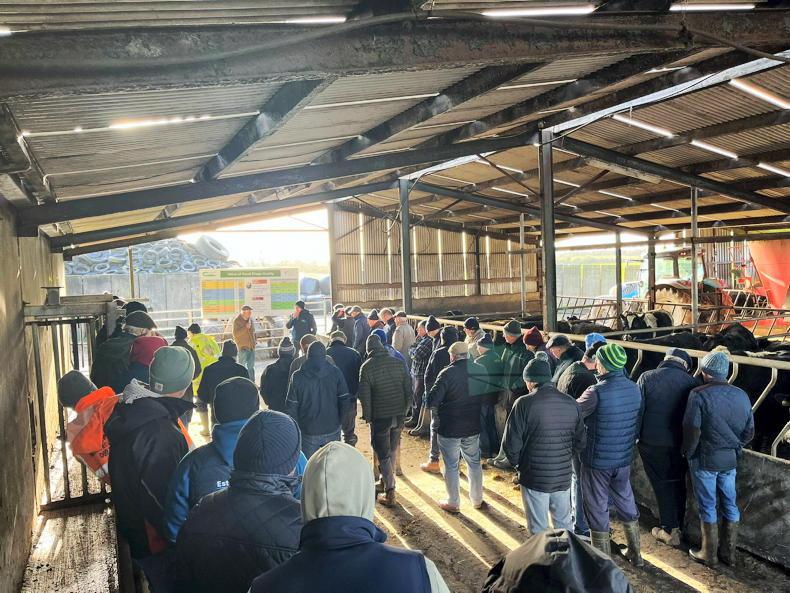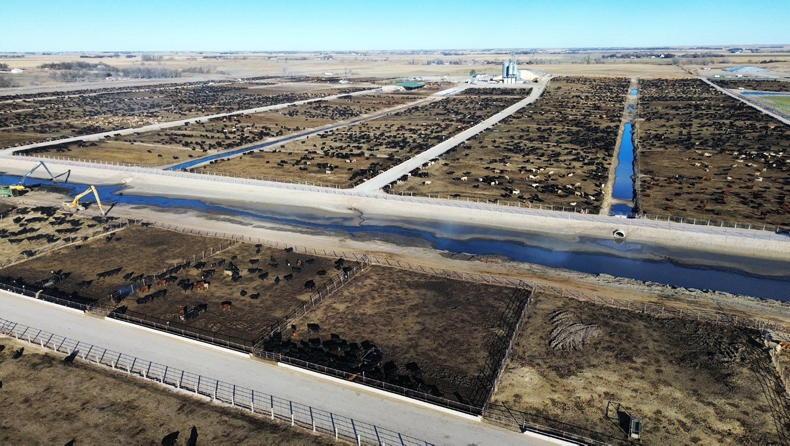The dairy beef index (DBI) is an index for identifying bulls that are both easy calving and have excellent carcase traits. The DBI selects for:
Easy calving.Short gestation. Less calf mortality.Heavier carcases of greater conformation and lower fat score.Cattle that are polled and docile with lower feed intake.The relative emphasis of the main groupings of traits in the index are: beef (62%), calving (31%), carbon (7%)
Improvements to the DBI
Updated economic values: Economic values were updated to reflect the price paid for cattle in recent years. This has resulted in higher economic values being applied to carcase traits in the DBI.
New trait – age at slaughter: due to new research in Teagasc, the DBI now includes an age at slaughter trait which identifies sires that will have progeny ready for slaughter at a younger age. Age at slaughter is included in the updated DBI at cost of €1.35/day, which represents the average cost of keeping animal across the year.

Glenford Pretty Lady that sold for €3,100. \Alfie Shaw
New trait – in-spec: A new composite ‘in-spec’ trait was introduced with the aim of identifying progeny that conform to desired factory specifications for carcase weight (280-380 kg), conformation (O= and better), and fat (2+ to 4=). Cattle that do not meet desired specifications are penalised in the factory and the DBI now reflects those penalties.
Inclusion of a
carbon sub-index
Carbon emissions from the dairy and beef herd are a major concern.
Although carbon is not a direct economic cost for farmers today, it is likely farmers will be charged for carbon in the future so the inclusion of a carbon component in the DBI will breed an animal with a lower carbon footprint.
The agricultural sector has been set a target of reducing emissions by 25% (5.75 Mt CO2e) by 2030. Genetics has been tasked with reducing this figure by 1.2Mt of CO2e and the inclusion of a new carbon sub--ndex into the DBI is imperative to achieving this.
Carbon is being included by assessing the impact that each trait has on carbon production. The carbon value is assessed as the change in total emissions per unit change in the trait of interest, holding all other traits constant. Traits that increase feed intake increase emissions and hence are penalised in the carbon sub-index.
Traits that reduce feed intake or change diet reduce emissions and hence, are rewardedin the sub-index.
Total carbon value is converted to an economic value by a price per tonne of carbon; this has been set at €80/t.
Traits included in the DBI carbon sub-index are:
1 Gestation.
2 Carcase weight.
3 Age at slaughter.
Animals that have a genetically short gestation length, produce lighter carcases and those that finish earlier in life benefit the most from these changes.
Guide to reading the DBI table
Bull details: rank, AI code, bull name, breed, Gene Ireland.
GI: This indicates whether the bull was progeny tested through the ICBF Gene Ireland progeny test programme or not.
DBI details: DBI, dairy beef index (€); the DBI ranks beef bulls, for use in the dairy herd, according to their genetic merit for a range of calving performance and carcase performance traits.
The overall DBI is expressed in euros. Each €1 increase in DBI can be interpreted as a €1 expected increase in profit for that bull’s progeny compared to progeny born to the average Holstein-Friesian bull.
For example, a beef bull with a DBI of €100 is expected to produce progeny born to dairy cows that will generate €100 more profit compared to progeny sired by the average Holstein-Friesian bull.
Therefore, higher-DBI bulls generate more profitable progeny.
Rel%: Reliability of DBI proof. This indicates the level of confidence that someone can have in a breeding value figure. The higher this value, the more reliable the proof.
Progeny records: The number of calves with calving surveys out of dairy cows is shown. The number of carcase weight records is the total number of progeny with carcase records out of both beef and dairy cows.
Semen details: Price, availability and supplier details of each bull are also included. These details are updated by each AI organisation for their own bulls.
The dairy beef index (DBI) is an index for identifying bulls that are both easy calving and have excellent carcase traits. The DBI selects for:
Easy calving.Short gestation. Less calf mortality.Heavier carcases of greater conformation and lower fat score.Cattle that are polled and docile with lower feed intake.The relative emphasis of the main groupings of traits in the index are: beef (62%), calving (31%), carbon (7%)
Improvements to the DBI
Updated economic values: Economic values were updated to reflect the price paid for cattle in recent years. This has resulted in higher economic values being applied to carcase traits in the DBI.
New trait – age at slaughter: due to new research in Teagasc, the DBI now includes an age at slaughter trait which identifies sires that will have progeny ready for slaughter at a younger age. Age at slaughter is included in the updated DBI at cost of €1.35/day, which represents the average cost of keeping animal across the year.

Glenford Pretty Lady that sold for €3,100. \Alfie Shaw
New trait – in-spec: A new composite ‘in-spec’ trait was introduced with the aim of identifying progeny that conform to desired factory specifications for carcase weight (280-380 kg), conformation (O= and better), and fat (2+ to 4=). Cattle that do not meet desired specifications are penalised in the factory and the DBI now reflects those penalties.
Inclusion of a
carbon sub-index
Carbon emissions from the dairy and beef herd are a major concern.
Although carbon is not a direct economic cost for farmers today, it is likely farmers will be charged for carbon in the future so the inclusion of a carbon component in the DBI will breed an animal with a lower carbon footprint.
The agricultural sector has been set a target of reducing emissions by 25% (5.75 Mt CO2e) by 2030. Genetics has been tasked with reducing this figure by 1.2Mt of CO2e and the inclusion of a new carbon sub--ndex into the DBI is imperative to achieving this.
Carbon is being included by assessing the impact that each trait has on carbon production. The carbon value is assessed as the change in total emissions per unit change in the trait of interest, holding all other traits constant. Traits that increase feed intake increase emissions and hence are penalised in the carbon sub-index.
Traits that reduce feed intake or change diet reduce emissions and hence, are rewardedin the sub-index.
Total carbon value is converted to an economic value by a price per tonne of carbon; this has been set at €80/t.
Traits included in the DBI carbon sub-index are:
1 Gestation.
2 Carcase weight.
3 Age at slaughter.
Animals that have a genetically short gestation length, produce lighter carcases and those that finish earlier in life benefit the most from these changes.
Guide to reading the DBI table
Bull details: rank, AI code, bull name, breed, Gene Ireland.
GI: This indicates whether the bull was progeny tested through the ICBF Gene Ireland progeny test programme or not.
DBI details: DBI, dairy beef index (€); the DBI ranks beef bulls, for use in the dairy herd, according to their genetic merit for a range of calving performance and carcase performance traits.
The overall DBI is expressed in euros. Each €1 increase in DBI can be interpreted as a €1 expected increase in profit for that bull’s progeny compared to progeny born to the average Holstein-Friesian bull.
For example, a beef bull with a DBI of €100 is expected to produce progeny born to dairy cows that will generate €100 more profit compared to progeny sired by the average Holstein-Friesian bull.
Therefore, higher-DBI bulls generate more profitable progeny.
Rel%: Reliability of DBI proof. This indicates the level of confidence that someone can have in a breeding value figure. The higher this value, the more reliable the proof.
Progeny records: The number of calves with calving surveys out of dairy cows is shown. The number of carcase weight records is the total number of progeny with carcase records out of both beef and dairy cows.
Semen details: Price, availability and supplier details of each bull are also included. These details are updated by each AI organisation for their own bulls.











SHARING OPTIONS